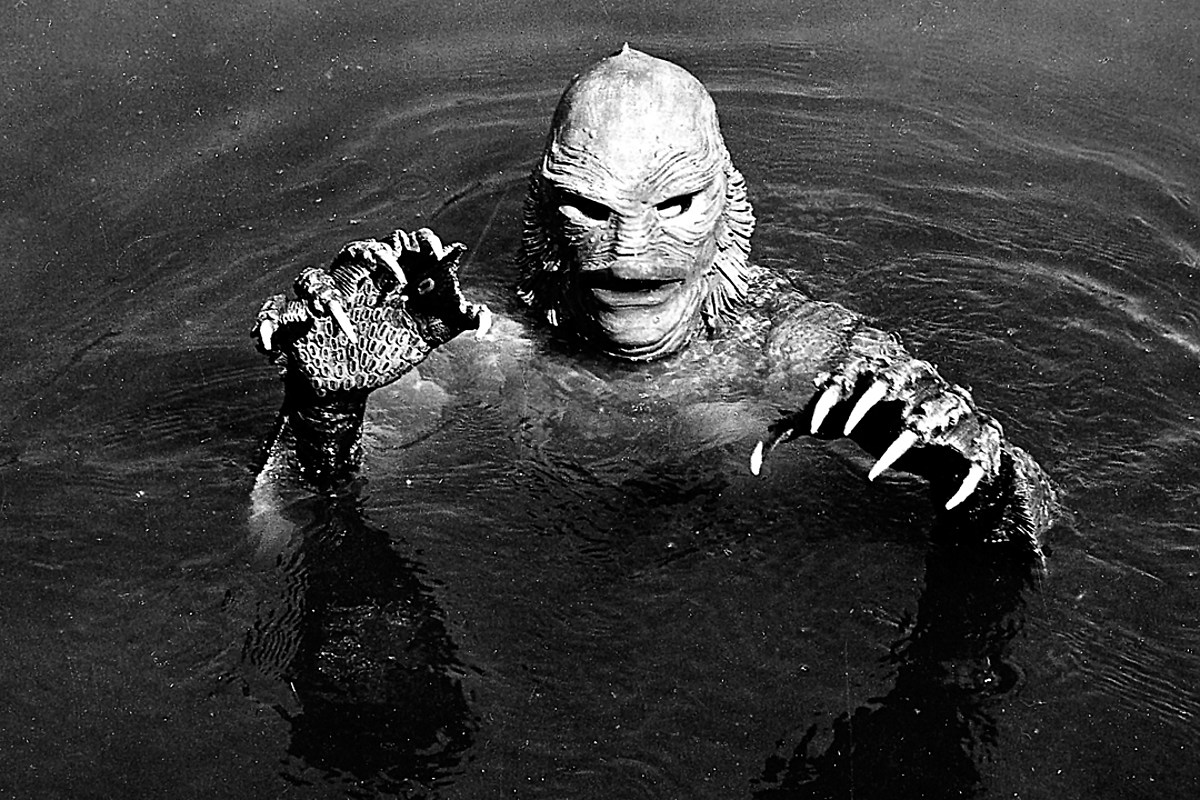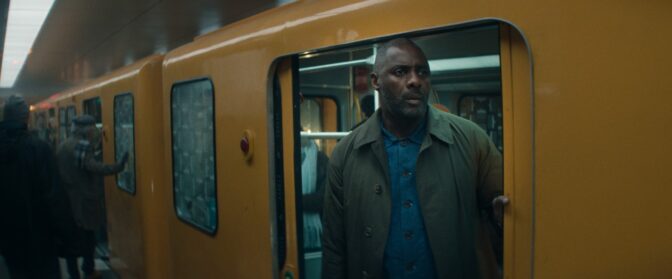The title character of “Creature from the Black Lagoon” is both beautiful and terrifying: a prehistoric humanoid who lives in the Amazon River, surfacing to menace a boat full of Yankee explorers and lust after a beautiful young woman on their crew. He has long, taloned fingers and a round head with fins where humans would have ears (protecting his gills). His body is covered in segmented armor. In repose, the creature breathes slowly and stares straight ahead. He almost looks as if he’s meditating. Seen in shadow or silhouette, his outline evokes demonic or supernatural figures from medieval paintings and poems: a damned knight who has come back from Hell to wreak havoc.
The Gill Man—as he was later nicknamed by fans—is the best reason to re-watch the original 1954 film, which was recently released on 4K by Universal in an “Icons of Horror Collection” along with “The Mummy,” “The Bride of Frankenstein,” and “Phantom of the Opera.” Ostensibly created by makeup artist Bud Westmore—who was working for Universal at the time, and who was part of the Westmore dynasty of movie effects artists, which has continued into the present day—the Creature was really a labor of love by Milicent Patrick, an artist and sculptor who came up with the Gill Man head and suit while employed by Universal’s special effects department. As chronicled in Mallory O’Meara’s book The Lady from the Black Lagoon, her contributions were minimized almost to the point of invisibility by Westmore, who by the common agreement of colleagues lacked the imagination and skills to create such a haunting design.
The second-best reason to watch the original is the filmmaking, which doesn’t invent anything, but polishes up familiar monster movie story beats and images with conviction, flair, and a voluptuous sense of atmosphere. It was directed by Jack Arnold, who had become one of Universal’s go-to horror filmmakers by the early ‘50s, and written by the team of Harry Essex and Arthur Ross, who specialized in horror, gangster pictures, and other genre movies. Together with the cast and crew, they keep the story chugging along. Even by the accelerated standards of modern features, the second half is enthralling: it’s a cat-and-mouse game pitting the boat crew against the Gill Man. The end result is a compact and intelligent genre piece that fuses elements of the jungle adventure, the horror film, and the environmental cautionary tale, plus trace elements of the original “King Kong,” an earlier classic about a prehistoric jungle creature who kidnaps a human woman from a band of explorers.

As explained in a Den of Geek piece by my friend Jim Knipfel, “Creature” was the brainchild of William Alland, a friend of Orson Welles who heard a cinematographer tell the story of “an amphibious humanoid creature who emerged from the Amazon once a year, grabbed a young woman from a local village, and then disappeared again. The other guests got a chuckle out of that, but the cinematographer insisted it was absolutely true, even offering to provide photographic evidence. It’s unclear if anyone ever took him up on that.” When Alland started producing movies for Universal, he wrote a treatment for a script that was essentially “King Kong, but with a human-sized amphibian,” starting the story in the jungle and ending it in the city, where the monster escapes confinement and runs amok. The second half of the story was nixed when the film began production and hired proper screenwriters (it was probably un-doable anyway, given the limited budget), but it ended up being resuscitated and scaled down for the first sequel, “Revenge of the Creature,” in which the Gill Man becomes an “attraction” at a theme park. Shot and released in 3-D format at the height of the craze, “The Creature” was a surprise smash, earning back ten times its $500,000 production budget and becoming the first entry in a trilogy.
“Creature from the Black Lagoon” was a late and quite unexpected addition to Universal Studios’ gallery of classic movie monsters—part of a line of icons that dated back to 1931 with the release of the original “Dracula” and “Frankenstein” and continued through the 1940s and ’50s with the likes of “The Wolf Man,” “The Invisible Man,” “The Mummy,” “The Black Cat,” and various originals, adaptations, and sequels that played on the studio’s successes. In the middle part of the 20th century, Universal’s brand was so strongly associated with its monster films that it continued to crank out new entries even after it had become harder to scare, or even surprise, audiences. By the late 1940s and early ‘50s, Universal was endlessly recycling the old hits, releasing films that ignored established details of geography and time period to pit, say, Frankenstein’s monster against the Wolf Man, or even bringing in Abbott and Costello (stars from Universal’s comedy roster) to be terrified by them. You could call this an early attempt at an “expanded universe” if the phrase existed back then.

If you think about the film’s images in context of movies that followed, you realize how artistically as well as commercially influential it was. Squint hard enough, and you can see trace elements of both the “unstoppable stalker” horror movie (represented by everything from “Halloween” and “Friday the 13th” to the original “Alien,” “Westworld,” and “The Terminator”). You can also see the future of aquatic monster movies like “Jaws” and its countless imitators: the shots of the monster’s quarry, researcher Kay Lawrence (Julie Adams), obliviously swimming in her pristine white bathing suit while the Gill Man backstrokes behind her in murky blackness are a premonition of the iconic lobby poster for the original “Jaws.”
And of course, Guillermo del Toro made his own version of the tale, and it ended up becoming a multiple-Oscar winner and a global blockbuster: “The Shape of Water,” a 1960s period piece wherein a mute cleaning woman at a top-secret government facility embarks on a sexual relationship with a Gill Man-type creature who’s being held by the CIA and cruelly experimented on. While del Toro’s political read on this story is overt—his aquatic man has an affinity for marginalized and persecuted individuals like himself and is tormented and pursued by an emotionally and sexually constipated, reactionary bully—the original also resonates with matters that were on American minds in 1954, the year that Brown vs. Board of Education was decided, and the Civil Rights movement grew in impact. The racist fear of miscegenation is encoded in the relentless threat of inter-species sex: in “Tarzan” and other pulpy adventures, indigenous people were constantly trying to kidnap and “marry” white interlopers’ women. And there’s a bitter isolationist aftertaste of two world wars and the Korean conflict in the interplay of white crewmembers and natives: if these spoiled, swaggering Americans hadn’t gone wandering abroad and mucking with indigenous ruins, relics and cultures, the Gill Man wouldn’t be picking them off one-by-one.
Beyond its fascination as a cultural object, “Creature from the Black Lagoon” is compelling entertainment that stands proudly alongside the original Universal horror classics. At a time when movies and television seem terrified to slow down even for a second, for fear of losing audiences to another streaming platform, the film’s willingness to let the viewer marinate in a moment makes an old work feel strangely fresh and new. Although it was aimed at teenage audiences, it’s a serious film with an adult sensibility. Its eye for beauty and belief in its ability to hold the viewer’s attention make it feel more like a contemporary “art house” horror movie than a 1950s studio attempt to make an exploitation picture.
Shot by William E. Snyder—who had worked on a film and a TV series about pirates, and knew a lot about shooting on and below water—it’s also a flat-out gorgeous work of popular art, showcasing black-and-white 35mm film’s ability to transform both real and studio locations into an experience that feels more figurative than literal. A black-and-white movie has a much easier time feeling like a representation of ideas and fears—like something in a fairy tale or a dream—rather than a set of situations that’s meant to be thought of as “realistic,” or at least “plausible.” What matters in a Universal horror film like “Creature” isn’t what’s happening, and how believable or logical it is, but what it makes you think about, and feel.
Still, if you don’t have a great monster, you’ll never have a great monster movie, and Gill Man’s debut is one of the greats. The movie wouldn’t work without Patrick’s extraordinary creature design and the performances of the actors who played the creature: Ben Chapman on land and Ricou Browning in the underwater sequences. Browning—who was then an actor, and went on to be an accomplished filmmaker—was a prodigious swimmer. That skill set allowed him to “act” the creature with his body by moving his head, limbs or torso in a certain way, as required by the script. The underwater scenes are shot and performed with such easygoing authority that they end up reinforcing the biggest limitation in the creature’s struggle to conquer his enemies: he’s at a disadvantage on land. Out in the open air, especially in daylight, the Gill Man is a formidable but limited foe, breathing loudly, and shambling only somewhat faster than one of Universal’s mummies. Immersed in the quiet gloom of the river, he’s liberated, swimming so fast that he seems to be flying. This is his domain. He was born for it.












